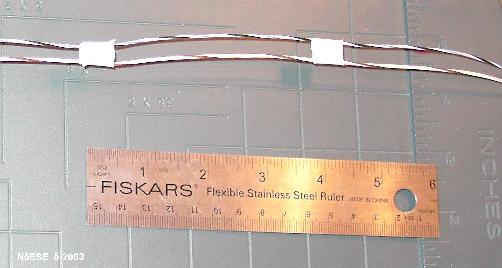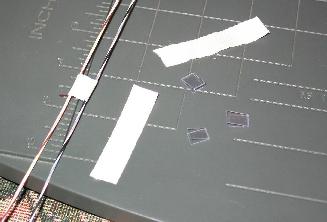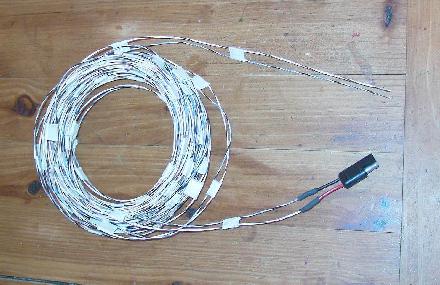
(click on any picture to see larger version)

Objective and Philosophy
The objective here was to construct a usable open-wire feedline that is lightweight and portable, for use with a lightweight doublet in the field. Uniformity was secondary to weight and flexibility. While the approximate characteristic impedance was calculated (by wire size and spacing) to be around 450 ohms, it is probably not uniform along its length. Commercial open-wire line is typically made with stiff, solid wire and very stiff spacers, so as to maintain the spacing (and hence, the characteristic impedance) very closely along the enttire length. This was deemed unecessary for QRP portable ops, as the objective was to provide low feedline losses to the target antenna, even with high SWRs. My belief is that as long as the spacing variations are a very small fraction of the wavelength, it is unlikely that such variations will effect a substantial shift in balance or performance.
Construction
From time to time on QRP-L, members are offered exceptionally good prices on teflon-insulated wire. I took advantage of this, and acquired five 50 ft rolls each of AWG22 and AWG24 wire. This is good stuff, stranded with 19 strands, and silver plated. I decided to construct a 44 ft section of non-resonant feedline using this wire.
For spacers, I found some scrap plastic, the clear kind they pack small items in so that you can see what you are getting, but you can't actually handle it (or steal it). You know the type, because when you get it home, it takes every knife in the house to open the pack (the stuff is tough!). I cut it into strips 3/16" wide, then into pieces about 1/2 inch long. When folded in half, they provide enough bulk to prevent two parallel wires from coming closer. We also cut 1/2-inch wide glass-cloth tape into 2 inch pieces. This is extremely rugged tape, very adhesive, and because it is made of glass, has good dielectric properties. Here's a picture of the parts:

With a convenient surface to lay the wire on, we place one of the plastic spacers between the two wires, and wrap the tape around it a couple of times, sealing the assembly in place. We did this at 4-inch intervals along the entire length, and it took us about three hours to complete the 44 ft section. We then placed a connector on one end (a Radio Shack 270-026) which is a rubberized and polarized connector set with pre-molded wires which happened to be about the same spacing as the feeder. This end will go to the doublet. On the other end, we stripped and tinned pigtails, for use with the binding posts on our various tuners. Here's a picture of the completed assembly, coiled to about a 6 inch diameter, which easily fits into a zip-lock bag:

The completed feedline is lighter than the cheap Radio Shack twinlead, and should be less lossy. And it's much lighter and more flexible than any commercial ladder line or open-wire line I've ever encountered. Because teflon has very good dielectric properties, the performance of this feedline should approach that of a bare wire feedline, including velocity factor (though that hasn't been measured)
Field Day 2003 served as the maiden voyage for this line, which performed well feeding a 40 Meter dipole at 30 ft on a DK9SQ mast. As an experiment, we attempted to load all the traditional bands 80-10 Meter plus 30 Meters. Using a Norcal BLT tuner, we were unable to load 80 or 20 or 10 Meters, but this was not surprising given the useful range of the BLT. Using the MFJ-971 Tuner, we were able to load all bands but could not get a match below 2:1 on 80 Meters. However, by tying the two feedline wires together at the tuner, and laying down a counterpoise, we were able to feed the antenna as a top-loaded vertical on 80. Unfortunately, activity on 80 Meters was very low at the time we tried. During 16 hours of QRP operating, concentrating mainly on 40 and 20 Meters - and having fun - we were able to garner 189 contacts (about 90 % of the stations we called). The antenna and feedline were easy to transport, raise, and tear down, and performed at least as well as expected.
I hope this encourages others to build their own open-wire feeders for portable application.
73,
Monty N5ESE
dit dididit dit